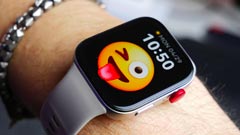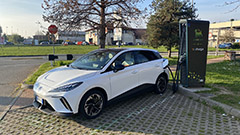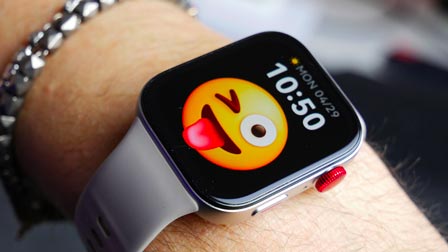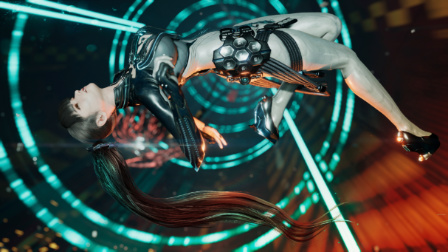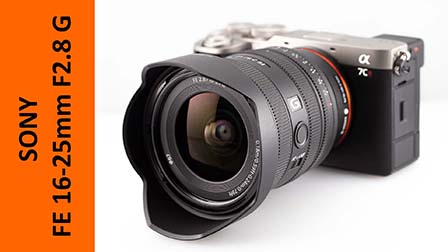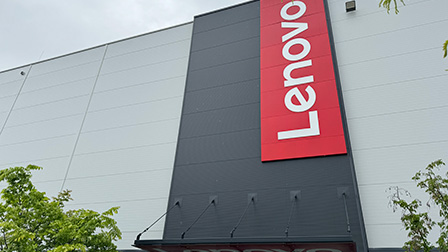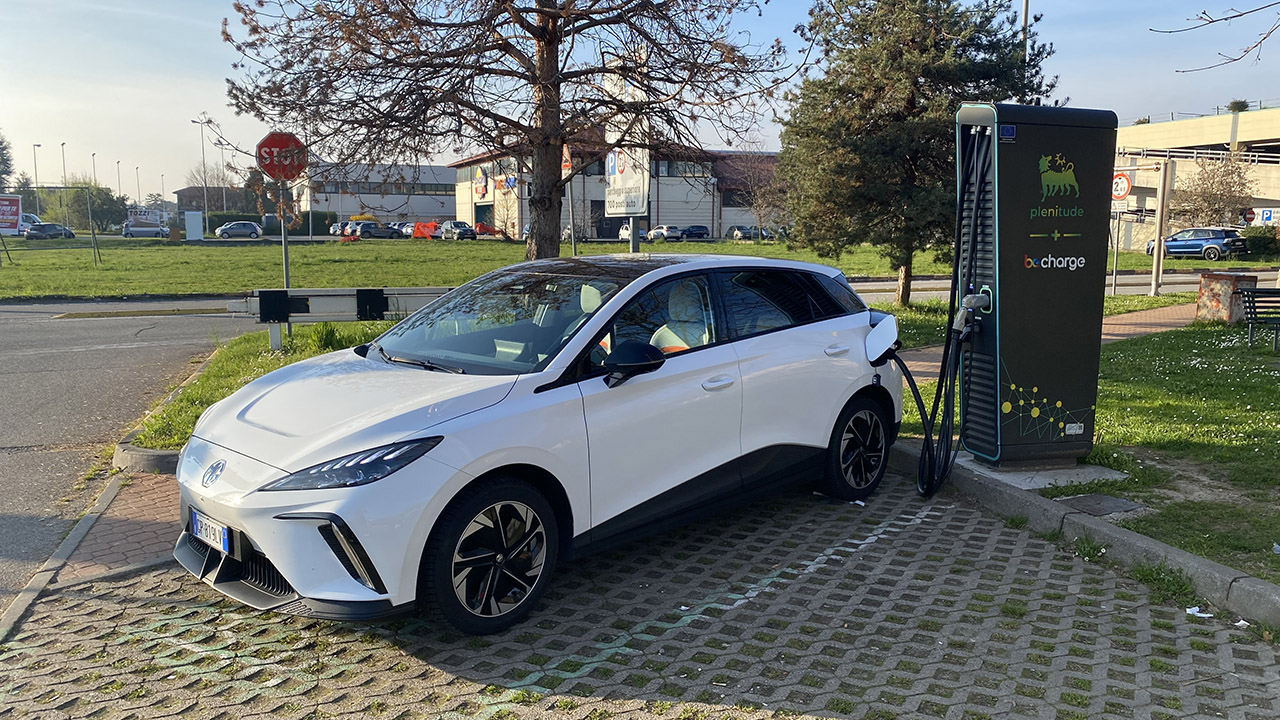|
|||||||
|
|
|
 |
|
|
Strumenti |
|
|
#61 |
|
Senior Member
Iscritto dal: Nov 2001
Città: Padova
Messaggi: 1635
|
Buon viaggio Rosetta!
__________________
Cosmos Pure | Core i7 860 | P7P55D-E Deluxe | 16GB DDR3 Vengeance | HD5850 | 2x850PRO 256GB | 2xRE3 250GB | 2xSpinPoint F3 1TB |
|
|

|
|
|
#62 |
|
Senior Member
Iscritto dal: Nov 2001
Città: Padova
Messaggi: 1635
|
0939 GMT (4:39 a.m. EST)
European Space Agency Director General Jean-Jacques Dordain reports that controllers are establishing contact with Rosetta. Rosetta is in a looping solar orbit that will see it intercept Earth a year from now for a pivotal sling-shot fly-by, receiving a gravity assist on its trajectory to ultimately reach the comet. The craft will later fly past Mars and Earth in 2007 and Earth once again in 2009.
__________________
Cosmos Pure | Core i7 860 | P7P55D-E Deluxe | 16GB DDR3 Vengeance | HD5850 | 2x850PRO 256GB | 2xRE3 250GB | 2xSpinPoint F3 1TB |
|
|

|
|
|
#63 |
|
Senior Member
Iscritto dal: Sep 2002
Città: torino but i'm sard inside.
Messaggi: 383
|
__________________
Primo Officiante della Setta dei Logorroici - Arconte della prolissità - Crociato della Replica|Custode Di Lomaghiusa e Muffin| |
|
|

|
|
|
#64 |
|
Senior Member
Iscritto dal: Nov 2001
Città: Padova
Messaggi: 1635
|
Rosetta begins its 10-year journey to the origins of the Solar System
2 March 2004 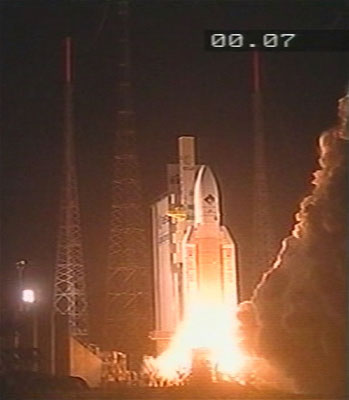 ESA PR 14-2004. Europe’s Rosetta cometary probe has been successfully launched into an orbit around the Sun, which will allow it to reach the comet 67P/Churyumov-Gerasimenko in 2014 after three flybys of the Earth and one of Mars. During this 10-year journey, the probe will pass close to at least one asteroid. Rosetta is the first probe ever designed to enter orbit around a comet’s nucleus and release a lander onto its surface. For over a year it will conduct a thorough study of this remnant of the primitive nebula which gave birth to our Solar System about 5 billion years ago. Rosetta’s mission began at 08:17 CET (07:17 GMT) on 2 March when a European Ariane 5 launch vehicle lifted off from the Guiana Space Centre, Europe’s spaceport in Kourou, French Guiana. The launcher successfully placed its upper stage and payload into an eccentric coast orbit (200 x 4000 km). About two hours later, at 10:14 CET (09:14 GMT), the upper stage ignited its own engine to reach an escape velocity in order to leave the Earth’s gravity field and enter heliocentric orbit. The Rosetta probe was released 18 minutes later. “After the recent success of Mars Express, Europe is now heading to deep space with another fantastic mission. We will have to be patient, as the rendezvous with the comet will not take place until ten years from now, but I think it’s worth the wait” said ESA’s Director General Jean-Jacques Dordain witnessing the launch from Kourou. ESA’s Operations Centre (ESOC) in Darmstadt, Germany, has established contact with the probe as it flies away from Earth at a relative speed of about 3.4 km/s. ESOC will be in charge of Rosetta operations and orbit determination throughout the mission. During the next eight months, the spacecraft’s onboard systems will be checked and its science payload will be commissioned. Then, it will be placed into hibernation mode for most of the ten years of its journey through the Solar System. A 10-year odyssey Rosetta will be reactivated for planetary flybys, which will be used to modify its trajectory through gravity assist manoeuvres, or asteroid flybys, observation of asteroids being one of the mission’s secondary objectives. The first planetary encounter will be in March 2005, as Rosetta flies by the Earth for the first time. The gravity assist will boost Rosetta into an orbit that will take it to Mars two years later. During its close encounter with Mars in February 2007, Rosetta will approach to a distance of about 200 km and conduct science observations. This Martian flyby will be followed by another Earth flyby in November the same year. Both planetary encounters will increase the probe’s orbital energy and boost it well into the asteroid belt. A third and last flyby of the Earth in November 2009 will send Rosetta toward the orbit of comet Churyumov-Gerasimenko. Then, by mid-2011, when it is about 800 million km from the Sun, Rosetta will ignite its main engine for a major deep-space manoeuvre that will place it onto an interception trajectory with the comet, which will take nearly three years to be reached. Rosetta will be reactivated for good in January 2014, as it enters a six-month approach phase, closing in slowly on the nucleus of comet Churyumov-Gerasimenko. The comet will then still be far from the Sun and its nucleus should be dormant. Rendezvous with a comet Like comet 46P/Wirtanen, which was the planned target for Rosetta until its launch was postponed in early 2003, comet 67P/Churyumov-Gerasimenko is one of the periodic comets that were “trapped” in the inner Solar System after they came too close to Jupiter. This comet was discovered in September 1969 at the Almaty Astrophysical Institute in Kazakhstan. It was detected by astronomer Klim Churyumov, from the University of Kiev, Ukraine, on pictures taken by his colleague Svetlana Gerasimenko, from the Institute of Astrophysics of Dushanbe, Tajikistan. Study of its orbit shows that it was captured quite recently, after too close encounters with Jupiter in 1840 and 1959. The comet is now revolving around the Sun every 6.6 years on an elliptical orbit with a low inclination compared to that of the Earth. Its perihelion (the closest point of its orbit to the Sun) is located between the orbits of the Earth and Mars, while its aphelion (the farthest point) is beyond Jupiter. In preparation for Rosetta’s mission, the comet’s nucleus was observed by the Hubble Space Telescope, which revealed an irregular body about 4 km in diameter. Being a relatively “fresh” comet in the inner Solar System, 67P/Churyumov-Gerasimenko is a promising target for the study of primitive Solar System material. Rosetta will enter an orbit about 25 km above the nucleus in August 2014. It will then conduct detailed mapping of its surface and a landing site will be selected for Philae, its 100 kg lander. Philae will be dropped from an altitude of about 1000 meters and, due to the tiny gravity of the nucleus, it will touch down at walking speed. The lander will even have to anchor itself to the surface with a harpoon to avoid bouncing back. Philae will operate from the surface for at least a week, sending back very high resolution pictures and as information about the upper crust of the nucleus. These data will be relayed to Earth by the orbiter. Rosetta will continue its observations of the comet’s nucleus for over a year, at least until December 2015, and will have a ringside seat to monitor the « awakening » of the comet’s activity as it comes closer to the Sun and reached its perihelion, in October 2015. Probing the comet The Rosetta probe was built for ESA by an industrial team of over 50 European companies led by EADS Astrium. It is a 3 tonne spacecraft with solar arrays spanning an impressive 32 metres. This is the first probe designed to travel beyond the orbit of Mars to rely on solar cells for its power supply. In addition to the Philae lander, Rosetta incorporates a 165 kg science payload consisting of 11 instruments developed in partnership by ESA member countries, the United States, Greece, Hungary and Taiwan. Four of these instruments are dedicated to observation of the nucleus: the ALICE ultraviolet spectrometer, the OSIRIS high-resolution camera, the VIRTIS imaging spectrometer and the MIRO microwave radiometer/spectrometer. Three more instruments will study the composition of the nucleus and its emanations; the COSIMA and ROSINA spectrometers and the MIDAS microscope. The GIADA collector will analyse dusts in the vicinity of the nucleus while the RPC group of sensors will characterise the internal structure of the comet’s coma and its interaction with the solar wind. The last two instruments, CONSERT and RSI, will use radio waves, one to probe the internal structure of the nucleus and the other to determine the distribution of masses inside the nucleus and the structure of the coma. The Philae lander, developed under the leadership of Germany’s DLR aerospace research agency, carries 9 instruments provided by ESA member countries in partnership with the United States, Hungary, Poland and Russia. Among these, the ÇIVA/ROLIS set of cameras will provide panoramic and stereoscopic high-resolution views. The APXS, COSAC and Ptolemy instruments will analyse soil compounds. The SESAME seismometer will probe the surface to a depth of 2 m, while its characteristics will be studied by the MUPUS instrument with sensors on the anchoring harpoon. The ROMAP magnetometer and a second model of the CONSERT experiment will study the magnetic field and its interactions with the solar wind. The Rosetta Stone -unearthed in Egypt more than 200 years ago– gave XIXth-century Egyptologists the keys to decipher hieroglyphic writing and to rediscover three millennia of forgotten Egyptian history and culture and in-depth study of a comet’s nucleus and asteroids by the Rosetta probe is expected to enable today’s science community to decipher the mystery of the origins of our Solar System and to better understand the mechanisms ruling the formation of planetary systems around other stars.
__________________
Cosmos Pure | Core i7 860 | P7P55D-E Deluxe | 16GB DDR3 Vengeance | HD5850 | 2x850PRO 256GB | 2xRE3 250GB | 2xSpinPoint F3 1TB |
|
|

|
|
|
#65 |
|
Senior Member
Iscritto dal: Nov 2001
Città: Padova
Messaggi: 1635
|
Rosetta soars on ambitious comet intercept mission
BY STEPHEN CLARK AND JUSTIN RAY SPACEFLIGHT NOW Posted: March 2, 2004 Embarking on its epic voyage to gain new insights into comets and the history of our solar system, the Rosetta spacecraft was successfully launched today to rendezvous with a cosmic snowball and deploy a tiny lander onto its icy heart. The Ariane 5 rocket fired up at 0717:44 GMT (2:17:44 a.m. EST), exactly when the booster could place the probe on the first leg of its ten-year course to comet Churyumov-Gerasimenko. The Ariane solid rockets and first stage put Rosetta on an arcing suborbital ballistic trajectory about ten minutes after launch. The upper stage's Aestus engine fired nearly two hours after liftoff to send the 6,700-pound craft out of Earth's grasp and into solar orbit.  The Ariane 5 rocket sent Rosetta on its comet adventure today. Credit: ESA/CNES/Arianespace Rosetta aims to give scientists a wealth of knowledge about comets, frozen time capsules from billions of years ago, while helping the public at large wrestle some of the most fundamental questions that humans can ask. "I think it is very hard to imagine that you don't wonder sometimes what is it all about? Where did it all come from?" says European Space Agency science director David Southwood. "Once we were all star dust. How did we turn out to be the complicated beings that we are now? I think we are looking for some of the clues that will help us put that story together." Today's launch has been in the works since the Rosetta project began in 1993. Since then, the Rosetta team has been thrown a number of curves -- most recently the decision to delay the launch from January 2003 due to concerns with the reliability of the Ariane 5 rocket.  An artist's concept shows Rosetta and its looping route to the comet. Credit: EADS Astrium Delaying the launch from 2003 to 2004 caused managers to change targets for the probe, which required extensive studies of Churyumov-Gerasimenko to see if it was suitable to approach with a $1 billion spacecraft and safe to land upon with a tiny robot explorer. Rosetta will take a circuitous route through the solar system and will arrive back in the vicinity of Earth next March for its first crucial gravity assist fly-by. The probe will reach Mars in March 2007, followed by two additional close approaches of Earth to tweak its course toward Churyumov-Gerasimenko. Heading further from the Sun and past the asteroid belt, Rosetta will fly near several of these space rocks and study them from a distance of over a thousand miles before entering a hibernation period in mid-2011. "These brief encounters are a scientific opportunity and also a chance to test Rosetta's instrument payload," explained Rosetta project scientist Gerhard Schwehm from the European Space Agency. For two-and-a-half years, Rosetta's systems will be completely shutdown with the exception of its primary computer and radio receivers in order to conserve power. Fitted with two solar wings spanning almost 100 feet, the spacecraft will be the first to fly near the orbit of Jupiter and rely entirely on solar power. "To provide the probe with the power it needs in space, we have given it the biggest solar panels ever carried by a European satellite," said Manfred Warhaut, Rosetta's operations manager.  An artist's concept shows the Rosetta orbiter and its lander. Credit: EADS Astrium Rosetta will also undergo a number of other extended periods of inactivity between key mission events during the journey to Churyumov-Gerasimenko to relieve manpower and electrical constraints. Power production is strained for Rosetta because it will be traveling over 500 million miles from the Sun, where light levels are only four percent of those found on Earth. Controllers will bring Rosetta back to life in early 2014 for a thruster firing to slow the probe's approach to the comet before entering orbit and beginning its mapping and scientific mission to characterize the surface. "Rosetta carries more instruments than any previous scientific spacecraft -- that makes it challenging and one of the most exciting missions ever," said Claudia Alexander, U.S. project scientist for the mission from NASA's Jet Propulsion Laboratory. "We anticipate major discoveries, just like Galileo and Cassini." By the end of the summer in 2014, Rosetta will be in orbit around Churyumov-Gerasimenko and science operations should be in full swing. A major priority will be the determination of favorable landing sites for a small 220-pound lander carried aboard Rosetta named Philae.  Technicians work on the lander during pre-flight activities. Credit: EADS Space The three-legged Philae will touch down on the surface in November 2014, firing a harpoon to keep the tiny craft anchored on the comet so it doesn't float away in the weak gravitational field. It will snap high-resolution pictures and acquire data about the comet's organic crust and molecules for transmission up to the orbiter for later relay to Earth. Operating at least one week, perhaps significantly longer, Philae's instrument suite even includes a tiny drill that can bore a few inches into the comet for subsurface investigations. Together the orbiter and lander will observe the traits and changes the comet goes through as it approaches the Sun. Officially, the mission is slated to come to conclude in late 2015. "This will be our first ever chance to be there, first hand, so to speak, as a comet comes to life," Schwehm said. "As we will be accompanying Churyumov-Gerasimenko for two years, until the comet reaches its closest point to the Sun and travels away from it, we can at long last hope to acquire new knowledge about comets." Comet Churyumov-Gerasimenko was discovered in 1969 and is considered a dusty comet that is roughly two by three miles in diameter. The Hubble Space Telescope was chartered to observe the comet for 21 hours in March 2003 to gather more specific details about Churyumov-Gerasimenko to allow project officials to decide whether to pursue it as a potential target. "This comet has only about three-hundred-thousandths the gravity of Earth," said Alexander. "The Rosetta spacecraft will be able to make observations from as close as 2 kilometers (1.2 miles). The data from our state-of-the-art instruments will be amazing."  An artist's concept of the Rosetta orbiter and its tiny lander nearing the comet. Credit: ESA/AOES Medialab Scientists believe comets are made of the very same primitive materials that were present when the Sun and the solar system were formed an estimated 4.6 billion years ago. Comets are balls of ice and rock believed to be formed far beyond the orbit of Pluto where conditions are cold and dark, much like they were as the solar system was born. Some of these objects are drawn toward the inner solar system and they become comets -- giving us a unique view of almost the same primordial materials that played such important roles in the formation of the Sun and the planets. "They are the keys to understanding the way the whole solar system, the Earth, and how even we came into being. And with Rosetta we will be able to observe, study and analyze this primordial material up close for more than a year," said Paul Weissman of NASA's Jet Propulsion Laboratory. "We are confident we will come a step nearer to understanding the origins and formation of our solar system and the emergence of life on Earth," said Schwehm. Rosetta gets its name from the stone tablet found by French soldiers in Egypt in 1799 that contained the key to deciphering Egyptian hieroglyphics. Scientists hope this mission may unveil the mysteries surrounding how our planet and life came to be as we know it today.  The Rosetta spacecraft is illustrated in this artist's concept. Credit: EADS Astrium ESA managers are not lost on the difficulties associated with the mission. "Rosetta is one of the most challenging missions undertaken so far. No one has ever attempted such a mission, unique for its scientific implications as well as for its complex and spectacular interplanetary space maneuvers," Southwood said. "This mission will turn science fiction into science fact. Every aspect of comet Churyumov-Gerasimenko will be analyzed, resulting in the most comprehensive set of scientific measurements ever obtained of a comet," said Professor Ian Halliday, chief executive of the Particle Physics and Astronomy Research Council, which funded two of the instruments.
__________________
Cosmos Pure | Core i7 860 | P7P55D-E Deluxe | 16GB DDR3 Vengeance | HD5850 | 2x850PRO 256GB | 2xRE3 250GB | 2xSpinPoint F3 1TB |
|
|

|
|
|
#66 |
|
Senior Member
Iscritto dal: Nov 2001
Città: Padova
Messaggi: 1635
|
All systems GO for Rosetta
2 March 2004 Mission control for Rosetta has reported that the spacecraft's solar arrays were deployed at 10:54 CET and that the star-trackers' check was completed successfully at 12:30 CET. ESOC Control Room flight director Alan Smith reported that at 10:54, Rosetta's solar array was deployed on target, two hours and 38 minutes after launch. At 11:12, 'Sun Acquisition Mode' was achieved. This means that Rosetta can now use the Sun as its source of power on its way to Comet 67P/Churyumov-Gerasimenko. At 12:30, the star-trackers' check was completed and they were switched on. Rosetta uses star trackers to help fix its position and navigate its way to the comet. Three of the four reaction wheels were switched on exactly as planned. These help to stabilise the spacecraft. The first orbit estimation of Rosetta has been performed by the ESOC Flight Dynamics team. This orbit estimation is very close to what was expected. The spacecraft is stable and all systems are working well.
__________________
Cosmos Pure | Core i7 860 | P7P55D-E Deluxe | 16GB DDR3 Vengeance | HD5850 | 2x850PRO 256GB | 2xRE3 250GB | 2xSpinPoint F3 1TB |
|
|

|
|
|
#67 |
|
Senior Member
Iscritto dal: Sep 2002
Città: torino but i'm sard inside.
Messaggi: 383
|
qualcosa in italiano, per solleticare un pò la curiosità.
BERNA - Tutto bene per Rosetta. La sonda spaziale europea, partita stamattina a bordo di un razzo Ariane 5 dal poligono di Kourou nella Guyana francese, ha aperto i pannelli solari e imboccato la traiettoria per il suo lungo viaggio - 5 miliardi di km - verso la cometa 67P/Churyumov-Gerasimenko. Una volta raggiunto l´obiettivo, la sonda atterrerà sulla cometa: è la prima volta che si tenta un esperimento simile. La sonda è stata realizzata per studiare la composizione del nucleo della cometa. Per la sua realizzazione sono stati investiti circa 700 milioni di euro. La Confederazione vi ha partecipato con circa 26 milioni, dotando la missione di molte apparecchiature importanti. Fra queste uno spettrometro di massa a doppia messa fuoco, uno spettrometro per il tempo di volo e un sensore per la pressione dei gas, con i quali si può esaminare la composizione della cometa. Di produzione elvetica sono anche minicamere, obiettivi grandangolari per fotografare all´esterno, nonché l´antenna più importante della sonda, quella che mantiene i collegamenti con la terra. Le apparecchiature concepite dall´Istituto di fisica di Berna. La sonda ha la forma di un parallelepipedo di tre metri per due e una massa di 2905 kg; l´alimentazione elettrica è fornita da due pannelli solari che, una volta dispiegati, avranno una apertura di 65metri, quanto un campo di pallacanestro. Il lander ha una massa di 100 kg, di cui 27 kg di strumenti. (fonte: ATS)
__________________
Primo Officiante della Setta dei Logorroici - Arconte della prolissità - Crociato della Replica|Custode Di Lomaghiusa e Muffin| |
|
|

|
|
|
#68 |
|
Senior Member
Iscritto dal: Nov 2001
Città: Padova
Messaggi: 1635
|
Rosetta inizia il suo viaggio lungo 10 anni verso le origini del Sistema solare
2 Marzo 2004 ESA PR 14-2004. Rosetta, la sonda europea per le studio delle comete, è stata lanciata con successo in orbita attorno al Sole; da questa posizione potrà raggiungere la cometa 67P/Churyumov-Gerasimenko nel 2014, dopo tre passaggi attorno alla Terra e uno attorno a Marte. Durante questi 10 anni di viaggio la sonda passerà accanto ad almeno un asteroide. Rosetta è la prima sonda mai progettata a entrare in orbita attorno al nucleo di una cometa e a rilasciare un lander sulla sua superficie. Per oltre un anno condurrà uno studio approfondito di questi resti della nebulosa primitiva che ha dato origine al nostro Sistema solare circa 5 miliardi di anni fa. La missione Rosetta è iniziata alle 08.17 CET (07.17 GMT) del 2 marzo quando un veicolo di lancio europeo Ariane 5 si è staccato dal suolo del Centro Spaziale della Guyana, lo spazioporto europeo a Kourou, Guyana francese. Il vettore è riuscito a posizionare il suo stadio più elevato e il carico utile che trasportava in un’orbita eccentrica senza propulsione (200 x 4000 km). Circa due ore dopo, alle 10.14 CET (9.14 GMT), lo stadio superiore ha acceso il proprio motore per raggiungere una velocità di fuga che gli consentisse di lasciare il campo di gravità della Terra ed entrare in un’orbita eliocentrica. La sonda Rosetta è stata rilasciata 18 minuti più tardi. “Dopo il recente successo di Mars Express, l’Europa si dirige ora verso lo spazio profondo con un’altra fantastica missione. Dovremo essere pazienti poiché l’appuntamento con la cometa non avrà luogo che tra dieci anni ma credo valga la pena di aspettare” ha dichiarato Jean-Jacques Dordain, Direttore Generale dell'ESA, dopo aver assistito al lancio da Kourou. Il Centro di Controllo dell’ESA (ESOC) a Darmstadt in Germania ha stabilito i contatti con la sonda mentre si stava allontanando dalla Terra a una velocità relativa di circa 3,4 km/s. Il Centro ESOC sarà responsabile delle attività di Rosetta e della definizione dell’orbita per tutta la durata della missione. Durante i prossimi otto mesi verranno tenuti sotto controllo i sistemi a bordo del veicolo spaziale mentre verrà collaudato il suo carico utile. Poi, verrà posta in ibernazione per la maggior parte dei dieci anni del suo viaggio attraverso il Sistema solare. Un’odissea di 10 anni Rosetta verrà riattivata in corrispondenza dei passaggi planetari, che saranno sfruttati per modificare la sua traiettoria tramite manovre a effetto fionda, oppure in corrispondenza dei passaggi di asteroidi, dato che la loro osservazione è uno degli obiettivi secondari della missione. Il primo incontro planetario è previsto per marzo 2005 mentre Rosetta sarà in orbita intorno alla Terra per la prima volta. La manovra a effetto fionda lancerà Rosetta in un’orbita che le permetterà di raggiungere Marte due anni più tardi. Durante il suo incontro ravvicinato con Marte a febbraio del 2007, Rosetta si avvicinerà a una distanza di circa 200 km ed effettuerà osservazioni scientifiche. Questo passaggio marziano sarà seguito da un altro terrestre a novembre dello stesso anno. Entrambi gli incontri planetari incrementeranno l’energia orbitale della sonda e la accelereranno nella cintura degli asteroidi. Un terzo e ultimo passaggio intorno alla Terra a novembre 2009 invierà Rosetta verso l’orbita della cometa Churyumov-Gerasimenko. Poi, a metà del 2011, quando si troverà a circa 800 milioni di km dal Sole, Rosetta accenderà il suo motore primario per un’importante manovra nello spazio profondo che la posizionerà su di una traiettoria di intercettazione della cometa che verrà raggiunta dopo tre anni. La sonda verrà riattivata a gennaio inoltrato del 2014, quando entrerà in una fase di avvicinamento di sei mesi, avvicinandosi lentamente al nucleo della cometa Churyumov-Gerasimenko. La cometa sarà ancora lontana dal Sole e il suo nucleo dovrebbe essere quiescente. Incontro con una cometa Come la cometa 46P/Wirtanen, che è stato l’obiettivo programmato per Rosetta fino alla posticipazione del suo lancio all’inizio del 2003, la cometa 67P/Churyumov-Gerasimenko è una delle comete periodiche che sono state “intrappolate” nella parte interna del Sistema solare dopo essere giunte troppo vicino a Giove. Questa cometa è stata scoperta nel settembre del 1969, all’Istituto di Astrofisica di Almaty, in Kazakhstan dall’astronomo Klim Churyumov, dell’Università di Kiev, Ucraina, sulla base delle fotografie scattate dalla sua collega, Svetlana Gerasimenko, dell’Istituto di Astrofisica di Dushanbe, in Tagikistan. Lo studio della sua orbita rivela che è stata catturata piuttosto di recente, dopo incontri troppo ravvicinati con Giove nel 1840 e nel 1959. La cometa ora sta compiendo la rivoluzione intorno al Sole ogni 6,6 anni, percorrendo un’orbita ellittica con un’inclinazione bassa rispetto a quella della Terra. Il suo perielio (il punto dell’orbita più vicino al Sole) si trova tra le orbite della Terra e di Marte, mentre il suo afelio (il punto più lontano) si trova oltre Giove. In preparazione alla missione Rosetta, il nucleo della cometa è stato osservato con il telescopio spaziale Hubble, che ha rivelato un corpo irregolare con un diametro di circa 4 km. Dato che si tratta di una cometa relativamente “fresca” nella parte interna del Sistema solare, 67P/Churyumov-Gerasimenko è un obiettivo promettente per lo studio del materiale primitivo del Sistema solare. Rosetta entrerà in orbita a circa 25 km sopra il nucleo nell’agosto del 2014. Condurrà poi una mappatura dettagliata della sua superficie e verrà scelto un sito di atterraggio per Philae, il suo lander di 100 kg. Philae verrà rilasciato da un’altitudine di circa 1000 metri e, data la scarsa gravità del nucleo, toccherà il suolo alla velocità di una camminata. Il lander dovrà persino ancorarsi alla superficie con un arpione per evitare di rimbalzare. Philae sarà operativo sulla superficie per almeno una settimana, rinviando immagini a risoluzione molto elevata e informazioni sulla crosta superiore del nucleo. Questi dati verranno ritrasmessi alla Terra dall’orbiter. Rosetta continuerà le sue osservazioni del nucleo della cometa per oltre un anno, almeno fino a dicembre 2015 e occuperà un posto in prima fila per monitorare il « risveglio » dell’attività della cometa man mano si avvicina al Sole e avrà raggiunto il suo perielio nell’ottobre 2015. Sondare la cometa La sonda Rosetta è stata costruita per l’ESA da un gruppo industriale costituito da oltre 50 aziende europee guidate da EADS Astrium. È un veicolo spaziale di 3 tonnellate con pannelli solari con un’imponente apertura di 32 metri. È la prima sonda progettata per viaggiare oltre l’orbita di Marte che basa la propria alimentazione sulle celle solari. Oltre al lander Philae, Rosetta trasporta un carico utile scientifico di 165 kg, costituito da 11 strumenti sviluppati in cooperazione dagli Stati membri dell’ESA, dagli Stati Uniti, la Grecia, l’Ungheria e Taiwan. Quattro di questi strumenti sono dedicati all’osservazione del nucleo: lo spettrometro ultravioletto ALICE, la fotocamera ad alta risoluzione OSIRIS, lo spettrometro ad immagini VIRTIS e lo spettrometro/radiometro a microonde MIRO. Altri tre strumenti, gli spettrometri COSIMA e ROSINA e il microscopio MIDAS, studieranno la composizione del nucleo e le sue emanazioni. L’analizzatore GIADA esaminerà le polveri in prossimità del nucleo mentre il gruppo di sensori RPC studierà la struttura interna della chioma della cometa e la sua interazione con il vento solare. Gli ultimi due strumenti, CONSERT e RSI sfrutteranno le onde radio, uno per sondare la struttura interna del nucleo e l’altro per determinare la distribuzione delle masse all’interno del nucleo e la struttura della chioma. Il lander Philae, sviluppato da DLR, l’agenzia di ricerca aerospaziali tedesca, leader del progetto, trasporta a sua volta 9 strumenti, forniti dagli Stati membri dell’ESA in collaborazione con gli Stati Uniti, l’Ungheria, la Polonia e la Russia. Tra loro il set di fotocamere ÇIVA/ROLIS riprenderà viste panoramiche e stereoscopiche ad alta risoluzione mentre gli strumenti APXS, COSAC e Ptolemy analizzeranno i componenti del suolo. Il sismometro SESAME sonderà la superficie a una profondità di 2 m mentre le sue caratteristiche verranno studiate dal MUPUS, lo strumento dotato di sensori posizionato sull’arpione di ancoraggio. Il magnetometro ROMAP e un secondo modello dell’esperimento CONSERT studieranno il campo magnetico e le sue interazioni con il vento solare. La Stele di Rosetta, portata alla luce in Egitto oltre 200 anni fa, ha fornito agli egittologi del XIX secolo le chiavi per decifrare la scrittura geroglifica e riscoprire tre millenni di storia e cultura egiziane dimenticate, mentre è previsto che lo studio approfondito del nucleo di una cometa e di asteroidi da parte della sonda Rosetta permetterà alla comunità scientifica odierna di decifrare il mistero delle origini del nostro Sistema solare e comprendere meglio i meccanismi che regolano la formazione dei sistemi planetari intorno alle stelle.
__________________
Cosmos Pure | Core i7 860 | P7P55D-E Deluxe | 16GB DDR3 Vengeance | HD5850 | 2x850PRO 256GB | 2xRE3 250GB | 2xSpinPoint F3 1TB |
|
|

|
|
|
#69 |
|
Senior Member
Iscritto dal: Sep 2002
Città: torino but i'm sard inside.
Messaggi: 383
|
MISSIONE TARGATA ITALIA
Tanta e qualificata la tecnologia italiana protagonista di una missione scientifica europea Un fiore all'occhiello per la tecnologia italiana la missione Rosetta, la prima destinata ad orbitare attorno ad una cometa e a rilasciare un veicolo che studierà da vicino i segreti del suo nucleo, vero e proprio fossile del Sistema Solare. "Ancora tanta tecnologia italiana protagonista di una missione scientifica europea", ha commentato l'amministratore delegato dell'Alenia Spazio, Maurizio Tucci. "Dopo il successo di Mars Express - ha rilevato - Rosetta ha a bordo tecnologie particolarmente sofisticate ed essenziali per i collegamenti tra la sonda e la Terra". Alenia Spazio (Finmeccanica) ha contribuito alla missione con l'integrazione della sonda nei suoi stabilimenti torinesi e realizzando lo speciale trasponditore digitale di bordo, essenziale per i collegamenti tra la sonda e la Terra. Capace di acquisire segnali debolissimi, il trasponditore è basato su un'architettura di elaborazione numerica dei segnali molto innovativa che costituisce, di fatto, la piattaforma di riferimento per tutte le missioni deep space. "Le soluzioni sviluppate da Alenia Spazio per il trasponditore digitale di bordo - ha rilevato Tucci - consentono infatti la trasmissione e ricezione a Terra, ad elevatissima qualità, dei segnali di telemetria contenenti i dati scientifici prodotti dagli strumenti della missione. Un lavoro altamente qualificato, quello dell'industria spaziale italiana - ha aggiunto - e frutto di una lunga acquisizione di know-how ed esperienza in uno dei pochi settori ad altissima tecnologia ancora presenti nel nostro Paese". (ANSA)
__________________
Primo Officiante della Setta dei Logorroici - Arconte della prolissità - Crociato della Replica|Custode Di Lomaghiusa e Muffin| |
|
|

|
|
|
#70 |
|
Senior Member
Iscritto dal: Nov 2001
Città: Padova
Messaggi: 1635
|
The making of an Ariane 5 launch
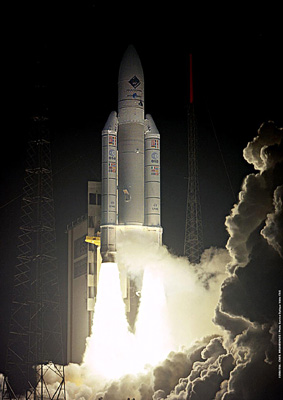 3 March 2004 As Ariane 5 sped into space carrying Rosetta, it was easy to forget that behind this and every launch is a cast of hundreds. These people have been working for many months to prepare Europe’s Spaceport in Kourou, French Guiana, for these brief minutes of excitement. Considering the hundreds of millions of kilometres that Rosetta will eventually travel to reach Comet 67P/Churyumov-Gerasimenko, it may at first seem strange that 99.8% of the propellant needed for the mission is consumed during the first hundred kilometres. This is because only in those first few minutes will the rocket be struggling both to slice a path through the atmosphere and to escape the pull of Earth’s gravity. In order to make the day go smoothly, around 200 people have worked for months to bring three critical elements of the launch to readiness at the same time. The three elements are the rocket itself, known as the launch vehicle, the Rosetta spacecraft and the launch base. Ariane 5 rockets are manufactured partly in Europe and partly in French Guiana. The European pieces are shipped to Kourou where the launcher is assembled with the locally manufactured elements. As soon as the hardware is ready and tested, the rocket’s flight software is loaded into its on-board computers so that it knows what to do! As for the spacecraft itself, as soon as the tests are finished in Europe, it too is shipped out to Kourou for final assembly, testing and fuelling. It is then mounted to the launch vehicle using a special adaptor that will release it into space once the rocket has done its job. One important part of the launch base is the meteorological station. It would be foolhardy to launch a rocket into a thunderstorm, as a lightning strike could seriously affect its electronics. Also, high winds at high altitude must be avoided. In the case of Rosetta, these winds indeed delayed the launch on 26 February 2004. Another part of the launch base is made up of the tracking stations. Rosetta’s Ariane 5 soon passed out of range of the Galliot tracking station, near Kourou, and was followed in its journey around the world by stations in Brazil, Ascension Island, Kenya, Australia and Hawaii. n order to know what to expect on the day, all these places had rehearsed the launch during the preceding months. Although every effort is made to minimise the risks, launches can still be dangerous. So on the day itself, all aircraft and ships are cleared from the immediate area. This is achieved using a standard, internationally applied procedure, also used to warn aircraft and shipping of military activities, accident sites and meteorological hazards. The launch of Rosetta was a particular challenge as it was the first time Ariane 5 had placed a spacecraft onto an Earth-escape trajectory. To do this, an unprecedented delayed ignition of the Ariane 5 upper stage was needed. 106 minutes after Rosetta had been placed into space, the upper stage ignited and powered Rosetta away from the Earth towards its icy rendezvous. The launch of any Ariane 5 is a grand symphony of human effort that reaches its unforgettable finale on the launch day itself. With Rosetta safely on its way, Europe’s Spaceport at Kourou now begins the whole process again in anticipation of its next, more standard, launch.
__________________
Cosmos Pure | Core i7 860 | P7P55D-E Deluxe | 16GB DDR3 Vengeance | HD5850 | 2x850PRO 256GB | 2xRE3 250GB | 2xSpinPoint F3 1TB |
|
|

|
|
|
#71 |
|
Senior Member
Iscritto dal: Nov 2001
Città: Padova
Messaggi: 1635
|
3 March 2004
The deployment of the high-gain antenna was successfully completed on 3 March at 03:23 CET. A test manoeuvre will be carried out at 12:45 CET to verify that all orbit and attitude control systems are working properly.
__________________
Cosmos Pure | Core i7 860 | P7P55D-E Deluxe | 16GB DDR3 Vengeance | HD5850 | 2x850PRO 256GB | 2xRE3 250GB | 2xSpinPoint F3 1TB |
|
|

|
|
|
#72 |
|
Senior Member
Iscritto dal: Sep 2001
Città: de_legato
Messaggi: 792
|
spero che non vorrete aggiornare questo thread per tutta la durata della missione!
__________________
---------------------------------------------- File reality.sys corrupted, Reboot Universe? Y/N ---------------------------------------------- |
|
|

|
|
|
#73 | |
|
Senior Member
Iscritto dal: Nov 2001
Città: Padova
Messaggi: 1635
|
Quote:
 
__________________
Cosmos Pure | Core i7 860 | P7P55D-E Deluxe | 16GB DDR3 Vengeance | HD5850 | 2x850PRO 256GB | 2xRE3 250GB | 2xSpinPoint F3 1TB |
|
|
|

|
|
|
#74 |
|
Senior Member
Iscritto dal: Nov 2001
Città: Padova
Messaggi: 1635
|
Rosetta's comet target seen from Earth telescope
EUROPEAN SOUTHERN OBSERVATORY NEWS RELEASE Posted: March 3, 2004 Rosetta's comet target seen from Earth telescope EUROPEAN SOUTHERN OBSERVATORY NEWS RELEASE Posted: March 3, 2004 In the morning of March 2, the Rosetta spacecraft was launched on board an Ariane 5 launcher from the European Spaceport in Kourou, French Guiana. The European Space Agency (ESA) spacecraft will be the first to land on a comet. Before the launch, and as a salute to their colleagues at ESA, astronomers used the New Technology Telescope at the European Southern Observatory (ESO) of La Silla in Chile to image Rosetta's target, Comet 67P/Churyumov-Gerasimenko, an approximately 4 kilometre size "dirty snowball" that orbits the Sun once every 6.6 years.  A composite image of the nucleus of Comet 67P/Churyumov-Gerasimenko (the point of light at the center), recorded on February 26, 2004, at 6:15 UT with the SUSI-2 camera on the 3.5-m New Technology Telescope. It is based on fifteen series of exposures seen in three different wavebands and since the images were aligned on the comet, the images of stars in the field are trailed. The fact that the image of the comet's 'dirty snowball' nucleus is almost star-like indicates that it is surrounded by a very small amount of gas or dust. The distance to the comet from the Earth was approx. 600 million km. Credit: ESO These new images show the object at a distance of approximately 670 million kilometres from the Sun - 4.5 times the distance from the Earth to the Sun. These observations provide further confirmation that at this distance the activity on 67P/Churyumov-Gerasimenko is very low. This is very good news for the mission, because it means that when Rosetta will meet in 2014 its target comet, at 790 million kilometres from the Sun, there will not be so much dust near the nucleus to hinder the landing. Originally timed to begin about a year ago, Rosetta's journey had to be postponed. This delay meant that the original mission's target, Comet Wirtanen, which was observed two years ago by astronomers using ESO's Very Large Telescope could no longer be reached. Instead, a new target has been selected, Comet Churyumov-Gerasimenko. The observations presented here are part of a continuous effort by astronomers to monitor Rosetta's target and provide the spacecraft controllers and the astronomers with very useful, regular updates, e.g., about the 'cometary weather' at the time of arrival.  The exposures have been combined to show the background objects in real colours. Because of its motion, the comet now appears as a trail. Credit: ESO
__________________
Cosmos Pure | Core i7 860 | P7P55D-E Deluxe | 16GB DDR3 Vengeance | HD5850 | 2x850PRO 256GB | 2xRE3 250GB | 2xSpinPoint F3 1TB |
|
|

|
|
|
#75 | |
|
Senior Member
Iscritto dal: Oct 2000
Città: UK
Messaggi: 7408
|
Quote:

__________________
"Questo forum non è un fottuto cellulare quindi scrivi in italiano, grazie." (by Hire) Le mie foto su Panoramio - Google Earth |
|
|
|

|
|
|
#76 | |
|
Senior Member
Iscritto dal: Nov 2001
Città: Padova
Messaggi: 1635
|
Quote:

__________________
Cosmos Pure | Core i7 860 | P7P55D-E Deluxe | 16GB DDR3 Vengeance | HD5850 | 2x850PRO 256GB | 2xRE3 250GB | 2xSpinPoint F3 1TB |
|
|
|

|
|
|
#77 |
|
Bannato
Iscritto dal: Sep 2002
Città: LA CITTA' PLURI-CAMPIONE D'ITALIA!
Messaggi: 5899
|
Il padre di un mio amico (iscritto al nostro forum come Bald0z ) ha lavorato in questo progetto,adesso lo informo di questo thread così magari da un suo contributo.
|
|
|

|
|
|
#78 | |
|
Senior Member
Iscritto dal: Nov 2001
Città: Padova
Messaggi: 1635
|
Quote:
__________________
Cosmos Pure | Core i7 860 | P7P55D-E Deluxe | 16GB DDR3 Vengeance | HD5850 | 2x850PRO 256GB | 2xRE3 250GB | 2xSpinPoint F3 1TB |
|
|
|

|
|
|
#79 | |
|
Senior Member
Iscritto dal: Mar 2000
Città: Vimodrone, Milano Est
Messaggi: 369
|
Quote:
L'Italia (come ASI, Agenzia Spaziale Italiana) ha partecipato a Rosetta con l'SD2 di progettazione Tecnospazio S.p.A. (Galileo Avionica). In pratica si tratta del "trapano" che effettuerà il buco sulla cometa per poi analizzarne i gas. Alcuni dirigenti di Tecnospazio sono stati inviati alla sede dell'ESA nei Paesi Bassi per seguire da vicino le ultime fasi di preparazione prima del lancio. Inoltre una collega di mio padre era a Kurou per assistere al lancio (in primavera 2003... poi rimandato a questa settimana).
__________________
Asrock 939Dual-SATA2 Bios 1.60 | Athlon64 Venice 3000+@3500+ (250x9.0 v-core default) | 4x256MB 2-2-2-7@166Mhz Utenti con cui ho trattato sul mercatino. |
|
|
|

|
|
|
#80 | |
|
Senior Member
Iscritto dal: Mar 2000
Città: Vimodrone, Milano Est
Messaggi: 369
|
Quote:
__________________
Asrock 939Dual-SATA2 Bios 1.60 | Athlon64 Venice 3000+@3500+ (250x9.0 v-core default) | 4x256MB 2-2-2-7@166Mhz Utenti con cui ho trattato sul mercatino. |
|
|
|

|

|
| Strumenti | |
|
|
Tutti gli orari sono GMT +1. Ora sono le: 03:27.









